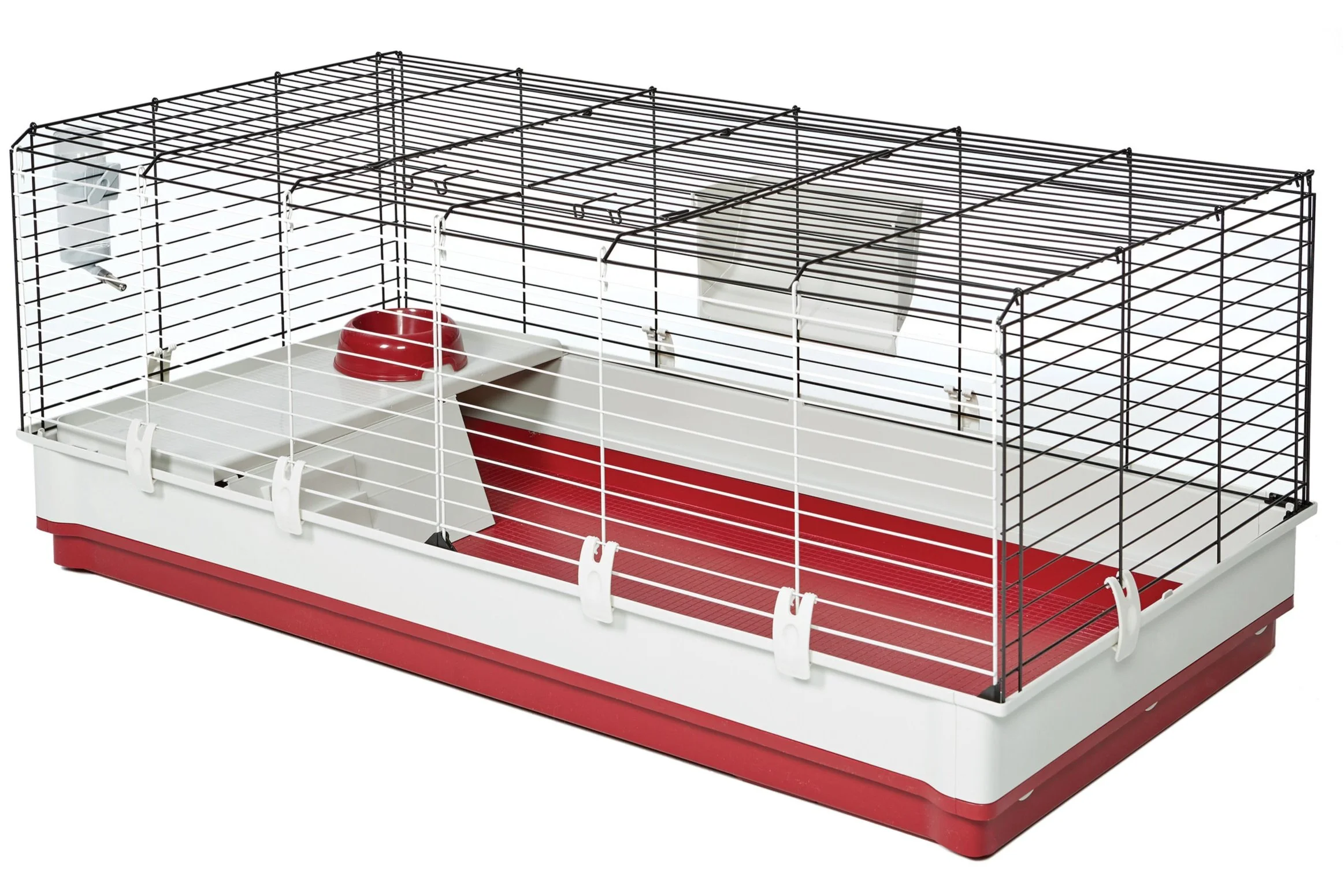
HOUSING
What’s the best cage for your rabbit?
Bunnies belong on floors, not in cages. Selecting the correct living space for your rabbit is a very important step in having a happy, healthy house bunny. A rabbit should have enough space to stretch out to their full size with space to hop around freely.
Cages are a hot topic in the online bunny community and do cause a bit of drama when it comes to what others believe is suitable for their pets. Often times new rabbit owners believe that a rabbit can live in the common, plastic store-bought cages that you can find in any pet store that sells guinea pigs or rabbits. However, this is untrue as a rabbit needs lots of space to stay healthy and happy. Here we will break down the options that we have experienced and what we would suggest to provide an even better living situation for you and your rabbit.
Cage
This is the most common form of housing we see, which can be purchased at almost every pet store. Unfortunately the suggested amount of space for rabbits isn’t sufficient enough for the size a rabbit grows once they hit adulthood. These are okay for keeping young rabbits until they have grown to the point they need more space, BUT we do not suggest keeping a full grown rabbit in these. Most of the time the hideout that comes attached can’t fit a full grown rabbit or could even be dangerous. There have been reports of rabbits getting their nails caught in the ledge and hurting themselves.
But what if this is all you can afford for the time being? How can you make this work? If the only space you can give your rabbit is this for 100% of their life, then you will want to look at other pets that can fit into the space you have available. HOWEVER, if you are able to pen around it and leave the door to the cage open, and let your rabbit out every day for a few hours to have free time where they can hop around and get exercise, as well as attention from their family, then you can make something like this work.
X-Pen
X-Pen cages have grown in popularity over the last few years because they are easy and relatively cheap to create. These give your bunny a lot of space to run around, making sure they aren’t confined to a small area all day. Of course your bunny would still need time out to explore and enjoy your home but this is a great inexpensive solution that gives your bunny 3x the space regular cages provide.
How do you make this “rabbit proof”? Of course just putting this on your carpet will give your bunny the opportunity to destroy your carpet. There are many solutions bunny owners have thought of to prevent this! Some buy area rugs to put underneath with another layer of plastic under that to protect the flooring of their home. Others buy rubber mats, the kind that you can buy at the hardware store or order online that are shaped like puzzle pieces. A few others have had success using outdoor rugs that are able to handle rain. Some materials are chewable and ingestable by rabbits leading to deadly intestinal blockage which can be fatal. Be sure that your rabbit is not prone to such chewing or else find a safer flooring option.
The last thing you have to be careful of is making sure you get an X-Pen that is high enough that a rabbit cannot jump over. These little trouble makers are great escape artists; once they learn they can jump over the top there’s nothing stopping them from it in the future.
Wire Bottom Cage
Wire bottom rabbit cages are also common among new rabbit owners because they are known for keeping their rabbits out of their poop. Rabbit feet were not made to stand on hard wire all day. These cages are linked with major cases of sore hocks which is when the sole of a rabbits foot is red and inflamed. This is very painful for a bunny to deal with as they use their feet for everything.
How can we make this work though? Many people use this cage similar to the first cage listed, as a home base for their rabbits with a pen around it. As long as the rabbit has a way to get off of the wire whenever they want this can still work as litter tray. You can put hay mats down on the floor of these to help prevent the sore hocks, or even cardboard. If this is the cage you are looking at to use just for a litter tray then we suggest looking for other, cheaper options that are all around easier to clean and better for your rabbits feet.
Hutch
Another common cage for rabbits are hutches. These cages are often times left outside and generally do not give enough space for a rabbit to live happily. Similar to wire bottomed cages, hutches can have mesh floors which as stated before cause sore hocks.
Some people choose to house their rabbits outside which can be dangerous when you take climate and predators into the equation. There is also Rabbit Hemorrhagic Disease, RHDV2, that spreads easily outside and is fatal to wild and domesticated rabbits. Housing rabbits indoors is found to be more humane, keeping our pets away from the heat, cold and anything outside that could scare or endanger them, from wild animals to chemicals you use on your yard.
When it comes to keeping your rabbit in a hutch indoors you have a lot of options to make it work with a pen and be comfortable for your bunny. If the bottom is wire or mesh you can use the methods mentioned in the Wire Bottomed Cage section above to protect your bunny from hurting their feet. If you have this cage and want to still utilize it for your rabbit the best way for that is to use it as a “home base” similar to how you would use the small pet store cage with a pen, where the rabbit is still able to travel around the house and get free time out of the hutch.
Kennel
If you want to give your bunny more space to hop around but not have to worry about him or her sitting on your carpet, an XL Dog Kennel is a great option for you. Many owners like to add a ledge to one side of the cage so their bunny can have a place to hide and a second level to explore. These give a good amount of space for your bunny as well as protect the floor of your home with the base of the kennel. If you are concerned about sore hocks with the bottom of this cage, you can line it with towels, fleece or even grass mats.
As with any other form of cage it is always vital for your rabbit to get time out to run and explore daily. Exercise is very important to calm some aggression as well as high strung and rabbits that like to destroy and be destructive.
C&C Grid Cage
This type of cage is relatively new and growing in popularity as social media shows off the ease, customization, and adaptability this style of cage has. Similar to the X-Pen cage, the C&C Grid Cage can be built and customized to the amount of space you feel necessary for your rabbit. These grid squares are actually storage shelves that you buy for your home. The bottom of the cage can be a rug, fleece or even towels. You can special order the waterproof outdoor rug for this as well. This is a great alternative if you want to be able to customize your shape and even add levels for your rabbit to explore.
If you do decide to add levels remember to put down wood or something else sturdy so your bunny doesn’t stand on the grid itself, as this can catch or cause issues with the feet.
Free Roam
Free roaming is the ultimate goal for many bunny parents, and is one of the best ways to keep your bunny happy. Of course there are a lot of reasons for not free roaming your bunny, but there are many more positive reasons for it.
A free roam bunny has full access to either an entire room or section of your home, or even your entire home, at all times, just like a cat or dog. When choosing this option for your rabbit please take into consideration how your rabbit acts when they are unsupervised. Don’t forget to bunny-proof EVERYTHING, especially the ‘spicy hay’ (cords).
When it comes to free roam, some bunnies get a little bored and decide something looks delicious, exciting, or just fun to sink their teeth into. Here are a few tips we bunny owners have learned to help save our houses and our rent deposits.
Use C&C grids or X-Pens to keep your bunnies away from your baseboards or areas of your home that you haven’t bunny-proofed.
TOYS! Have a selection of bunny toys you can switch out when your bunny gets bored.
Digging box- You can make a cheap digging box with a cardboard box and shredded pieces of paper. Sprinkle some snacks in there and your bunny will stay busy for hours!
Give them their own area- Have their litter box, food and water in an area that is all theirs. Don’t move this around so they can know this space is their very own.
Have multiple hides - bunnies can easily be spooked and should have a number of places they can run and hide when they are scared.
COVER ALL CABLES AND CORDS- often referred to as “spicy hay.” Bunnies love to sink their teeth into chargers, power cables or anything thin and plastic. It’s best to get cable covers at a hardware store to protect your bunny and your electronics.
Baby gates - these are great if you have a staircase you don’t want your bunny to climb or a room you don’t want to shut the door to but don’t want your bunny to have access to.
Bunny TNT hopes this guide assists you in choosing the best living situation for you and your bunny. There is a lot to learn when adopting and cohabitating with a bunny. If you have any questions regarding your rabbit, whether it’s housing, diet, behavior or anything else, don’t hesitate to reach out to us. We are here to help and want nothing more than for all domesticated rabbits to live long, healthy, and happy lives.







